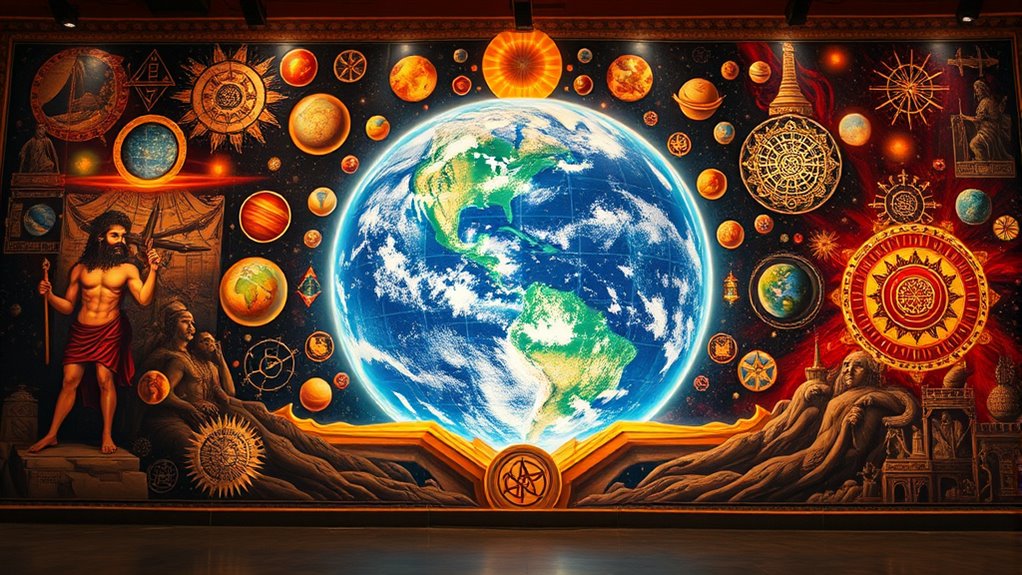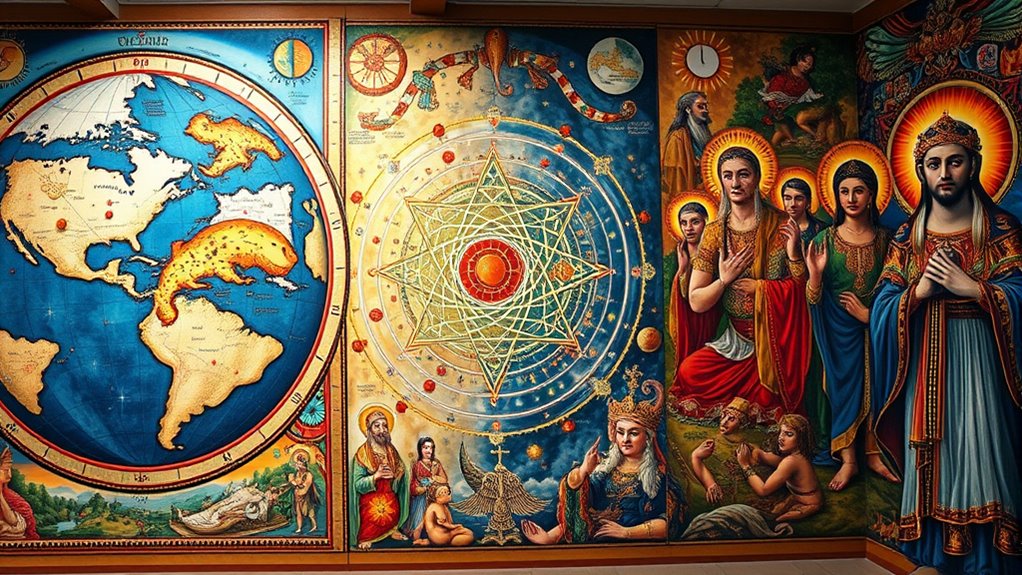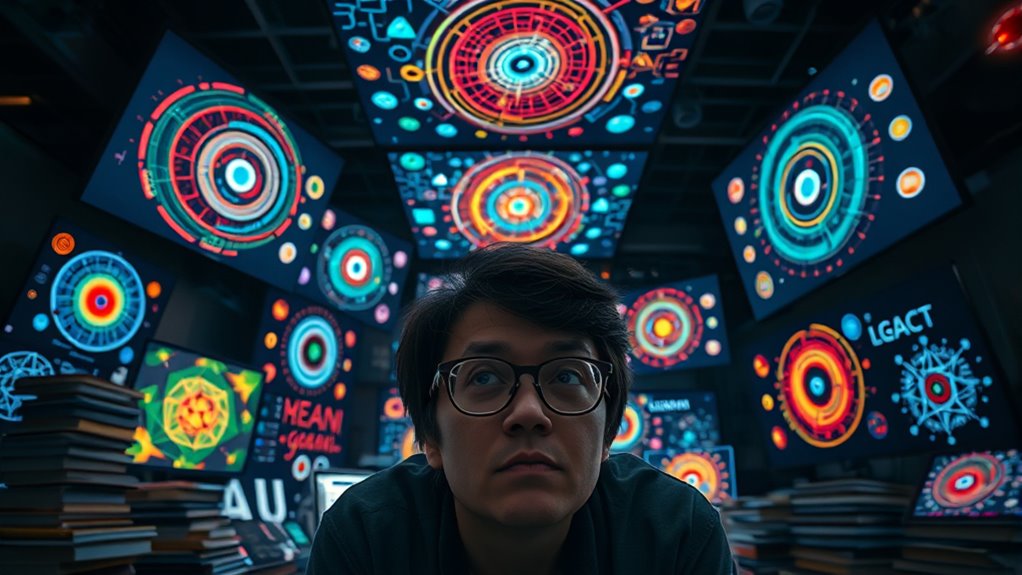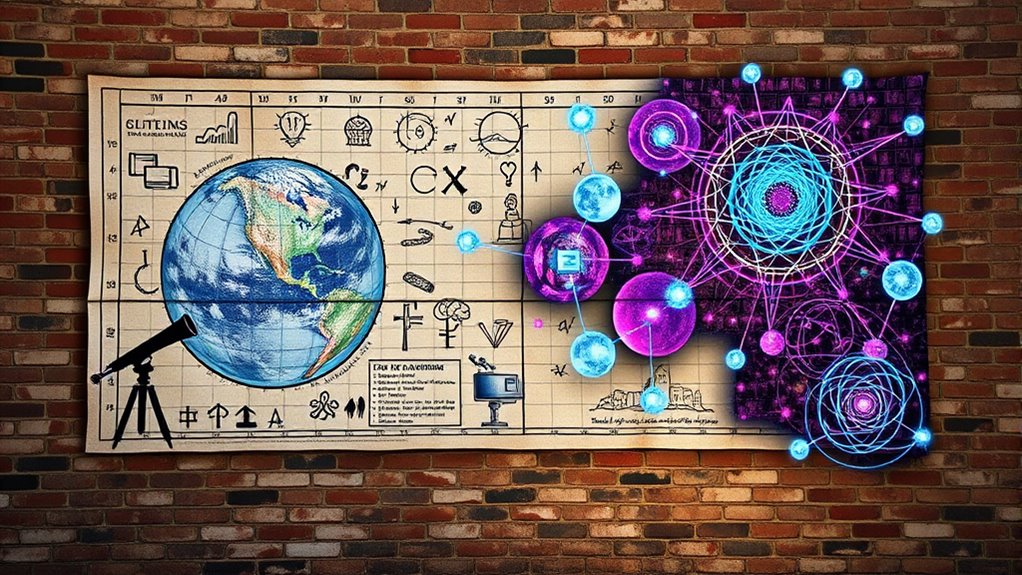Your exploration of belief systems reveals a journey from ancient cosmologies and mythic stories that explained the universe with divine symbols, to the rise of scientific methods that rely on evidence and observation. Modern movements, including flat Earth theories, alternative spirituality, and quantum woo, blend science, myth, and misinformation, shaping how we perceive reality. As you explore further, you’ll uncover how these ideas connect and evolve into a complex map of human understanding.
Key Takeaways
- Belief systems evolve from ancient cosmologies rooted in myth, symbolism, and sacred geometry, shaping perceptions of universe and divine order.
- Rituals and collective symbolism actively influence reality, reflecting the interconnectedness of spiritual beliefs and physical manifestation.
- Scientific inquiry transformed understanding from myth-based to evidence-based, challenging traditional views with empirical validation and paradigm shifts.
- Quantum physics introduces concepts like wave-particle duality and entanglement, inspiring new spiritual movements and beliefs about consciousness influencing reality.
- Modern digital information flow and neuroscience promote adaptable, interconnected belief systems blending science, spirituality, and mythic symbolism.
Ancient Cosmologies and the Flat Earth Model

Have you ever wondered how ancient civilizations viewed the universe? They often imagined it as a series of celestial spheres, each encasing the next, with Earth at the center. These spheres represented both physical realities and mythic symbolism, reflecting their spiritual beliefs. For example, the Greek geocentric model placed Earth beneath concentric celestial layers, with planets and stars embedded in transparent orbs. This cosmology reinforced the idea of a divine order, where the heavens were seen as a structured, sacred domain. Many cultures believed these celestial spheres moved in perfect harmony, embodying mythic themes of stability, divine authority, and cosmic unity. This worldview shaped their understanding of reality, blending observable sky phenomena with symbolic meanings rooted in their mythos. Additionally, these cosmologies often incorporated mythic symbolism to explain celestial movements and divine authority.
Religious and Mythological Perspectives on Reality

You see how sacred stories shape entire worldviews, offering explanations beyond the physical domain. Many traditions believe divine geometry and cosmic patterns reveal deeper truths about reality. Rituals, in turn, are seen as ways to influence or align with these sacred forces, shaping what is real. Such practices often aim to enhance cultural intelligence, fostering a deeper understanding of the diverse belief systems that inform different perceptions of reality.
Sacred Narratives and Worldviews
Sacred narratives and worldviews shape how cultures understand the nature of reality, offering frameworks that connect the divine, the cosmos, and human existence. They harness cosmic symbolism to depict universal truths and spiritual truths through mythic archetypes, which serve as recurring symbols embodying fundamental human experiences. These stories encode moral lessons, origins, and the structure of the universe, guiding communities’ perceptions of their place within a larger cosmic order. By interpreting celestial phenomena and natural events through sacred stories, cultures create meaning that sustains their worldview. Mythic archetypes like creators, tricksters, or guardians symbolize deeper spiritual principles, reinforcing shared beliefs. This symbolism helps individuals relate to their environment and existence, embedding spiritual significance into daily life and cultural identity. Additionally, the use of cosmic symbolism in these narratives often reflects observable natural phenomena, linking mythic stories directly to the physical world.
Divine Geometry and Cosmos
Divine geometry serves as a fundamental framework through which many religious and mythological traditions interpret the universe’s structure. Sacred geometry embodies the idea that specific geometric patterns and shapes reflect cosmic principles, revealing a divine order. These patterns, like the Flower of Life or the Sri Yantra, symbolize deeper truths about creation and unity. Cosmic symbolism integrates these geometric forms to articulate the interconnectedness of all things, portraying the universe as a sacred, harmonious entity. In these traditions, the universe isn’t random but structured by divine mathematical principles. You’re invited to see these symbols as more than art—they’re a language that encodes spiritual insights about the cosmos’s divine architecture. Sacred geometry, consequently, becomes a visual language for understanding the universe’s sacred design. Additionally, many of these geometric patterns are believed to embody universal harmony, reflecting the inherent balance present in the cosmos.
Rituals Shaping Reality
Throughout many religious and mythological traditions, rituals are seen as powerful acts that actively shape and reinforce reality itself. You participate in these acts through meditative symbols, which serve as focal points to connect with divine forces or cosmic truths. Ritual dances, performed with intention and rhythm, are believed to manifest spiritual energies, influencing the physical world. These practices are not passive; they create a sacred space where beliefs materialize into tangible outcomes. By engaging in these rituals, you align your consciousness with higher realities, reinforcing the fabric of existence. Whether through chanting, symbolic gestures, or movement, these rituals demonstrate that reality is flexible—malleable by shared intention, collective belief, and symbolic action. They exemplify how myth and religion actively shape the world around you. Additionally, the integration of AI security technologies into ritual practices could further enhance the precision and effectiveness of these spiritual acts.
The Rise of Scientific Method and Empirical Inquiry

The rise of the scientific method marked a pivotal shift in how humans seek knowledge, emphasizing observation, experimentation, and evidence over tradition or superstition. You now rely on empirical validation through systematic testing, which ensures ideas are verified objectively. Scientific methodology guides this process, helping you distinguish credible findings from mere speculation. This approach transformed philosophy into a disciplined pursuit of truth. To imagine this, consider the table below:
| Traditional Belief | Scientific Inquiry |
|---|---|
| Based on authority | Based on empirical validation |
| Superstition | Evidence-driven |
| Faith-based | Testable and repeatable |
| Tradition | Methodical experimentation |
This shift empowered humans to build reliable knowledge and challenge long-held assumptions. Empirical validation is central to ensuring the integrity of scientific conclusions.
Conspiracy Theories and Alternative Worldviews

Conspiracy theories often emerge from a need to explain complex or uncertain events outside mainstream narratives. Understanding their origins reveals how belief systems form and evolve, shaping alternative worldviews. By examining these dynamics, you can better see why some ideas persist despite a lack of evidence. Recognizing the influence of financial literacy can also shed light on how economic factors contribute to the development of alternative beliefs.
Origins of Conspiracies
Many conspiracy theories originate from a desire to make sense of complex or unsettling events, especially when official explanations seem unsatisfactory or incomplete. Their mythical origins often tie into cultural narratives that provide simple answers to difficult questions. These stories become embedded in collective memory, shaping perceptions and beliefs over time. You might see these ideas reinforced through symbols, rituals, or shared myths that resonate deeply within communities. To understand this, consider these elements: – Simplification of complex issues into a single cause – Use of mythic archetypes to explain events – Cultural stories that frame groups as villains or heroes – Reinforcement through media and social networks – A need for certainty amid chaos which can be influenced by cultural narratives or traditional beliefs. These components help create conspiracy theories rooted in cultural narratives, making them compelling and persistent.
Belief System Dynamics
Belief systems involving conspiracy theories and alternative worldviews often evolve through dynamic interactions between individual cognition and social influences. You’re influenced by cognitive biases like confirmation bias, which leads you to seek information that reinforces existing beliefs. Social reinforcement plays a key role, as group dynamics strengthen shared ideas and create echo chambers. When you encounter evidence that supports your worldview, belief reinforcement occurs, making your beliefs more resilient and harder to change. This cycle fuels the persistence of conspiracy theories and alternative narratives, even in the face of contradictory information. Understanding these dynamics helps you see how individual thought processes and social environments continually shape and sustain complex belief systems over time. belief reinforcement mechanisms, such as motivated reasoning, further entrench these systems by justifying deviations from factual evidence.
The Quantum Revolution and the Nature of Matter

Have you ever wondered how the tiniest particles shape the universe around us? The quantum revolution reveals that matter isn’t solid but behaves in strange ways. Concepts like wave-particle duality show particles act as both waves and particles, depending on observation. Quantum entanglement links particles instantly over vast distances, challenging classical ideas of separability. This shift changes how we understand reality at its core. Key ideas include:
- Particles exhibit wave-like behavior
- Observation affects particle states
- Entanglement links distant particles
- Uncertainty principle limits knowledge
- Matter exists in probabilities, not certainties
These discoveries revolutionize physics and influence how we interpret reality, belief, and the universe’s fundamental nature. The quantum view questions our traditional notions of matter, paving the way for new scientific and philosophical perspectives. Additionally, understanding the behavior of particles is crucial for developing advanced technologies like quantum computing.
New Age Movements and Spiritual Science

The discoveries in quantum physics challenge our traditional understanding of reality, inspiring a surge of interest in spiritual and metaphysical ideas. You might find yourself drawn to practices like energy healing, which claims to manipulate unseen forces for wellness. Astrological symbolism often appears in these movements, linking celestial patterns to personal destiny and energetic states. Many believe that quantum principles support the idea that consciousness influences matter, fueling claims that you can harness universal energies for healing or insight. These beliefs often blur the lines between science and spirituality, encouraging you to explore intuitive methods that claim to tap into higher dimensions of reality. While mainstream science remains skeptical, the appeal lies in the promise of personal empowerment through ancient symbols and new-age energy concepts.
Digital Age Beliefs: Memes, Misinformation, and Echo Chambers

In the digital age, information spreads rapidly through social media, shaping your perceptions and beliefs in ways that can be hard to track. Viral memes and misinformation spread quickly, often reinforcing biases and creating echo chambers. You may find yourself accepting ideas based on catchy images or sensational headlines without question. These dynamics make it easy to fall into confirmation bias, where you seek information that aligns with your existing beliefs. The echo chambers intensify this effect, isolating you from diverse perspectives. To navigate this, recognize that:
Viral memes and echo chambers distort facts, fueling confirmation bias and misinformation. Think critically and verify sources.
- Viral memes can distort facts
- Misinformation spreads faster than truth
- Echo chambers reinforce false beliefs
- Critical thinking is essential
- Source verification helps counteract misinformation spread
The Future of Human Understanding and Belief Systems

As technology continues to advance, your capacity to understand and shape belief systems will evolve in unprecedented ways. Neuroscience evolution uncovers how your brain adapts, rewires, and forms new cultural paradigms. These shifts will empower you to question long-held beliefs and embrace new perspectives. The future holds a landscape where information flows faster, and your beliefs become more flexible. The table below reflects the emotional impact of these changes:
| Fear | Hope | Empowerment |
|---|---|---|
| Uncertainty | Growth | Clarity |
| Resistance | Adaptation | Self-awareness |
| Isolation | Connection | Curiosity |
| Confusion | Enlightenment | Confidence |
| Loss | Innovation | Freedom |
Your evolving understanding will shape a more conscious, interconnected world.
Frequently Asked Questions
How Do Cultural Differences Influence Belief Systems Across History?
You see, cultural differences shape belief systems by influencing mythical narratives and societal norms. Across history, diverse traditions create unique stories that explain the world, guiding behaviors and values. These narratives, rooted in culture, affect how groups interpret reality and establish norms. As you explore different societies, you notice how beliefs evolve from these myths, reflecting the values and experiences that define each community’s worldview.
What Psychological Factors Make People Susceptible to Conspiracy Theories?
Imagine your mind as a ship steering stormy seas, vulnerable to unseen currents. Cognitive biases act like hidden currents pulling you toward conspiracy theories, making you accept unlikely ideas without question. Social influences are like friendly ships offering reassurance, encouraging you to believe and share. These psychological factors, combined with a desire for certainty and belonging, increase your susceptibility to conspiracy theories, steering your beliefs into uncharted waters.
Are There Neurological Bases for Belief Formation and Change?
You might wonder if there’s a neurological basis for belief formation and change. Research shows that neural circuitry, especially in the prefrontal cortex and limbic system, influences how you develop and modify beliefs. Belief plasticity refers to your brain’s ability to adapt these neural pathways over time. When presented with new information, your brain’s plasticity allows you to update or reinforce beliefs, highlighting the dynamic nature of belief systems.
How Does Language Shape Our Understanding of Reality?
You see, language shapes your understanding of reality through linguistic relativity and semantic framing, influencing how you interpret the world. The words and structures you use can emphasize certain concepts over others, guiding your perceptions and beliefs. When you choose different terms or frame ideas differently, you can change your mental outlook. This process subtly molds your reality, making language a powerful tool in shaping how you experience and understand the world around you.
Can Education Effectively Change Deeply Held Belief Systems?
You wonder if education can change deeply held beliefs. Educational interventions can influence belief resilience, but they often face resistance. When you challenge core beliefs, you may meet skepticism or denial. While education can introduce new perspectives, it doesn’t guarantee change overnight. You need patience, openness, and repeated exposure to different ideas. Ultimately, education can reshape beliefs, but it’s a gradual process that requires understanding how resilient those beliefs are.
Conclusion
You might think belief systems are just quirky ideas, but they shape how you see the world. Even if some theories seem far-fetched, they reveal your desire for meaning and certainty. Embracing scientific inquiry doesn’t mean dismissing curiosity; it’s about seeking truth without losing wonder. So, stay open-minded, question assumptions, and remember, your beliefs reflect your quest to understand the universe—an ongoing journey, not a fixed destination.









